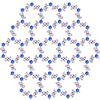| Apr 16, 2025 |
A 2D mechanically interlocked polymer mimicking chainmail shows high flexibility and stiffness, offering promise for lightweight protective and smart armor systems.
(Nanowerk News) Researchers at Westlake University have disclosed a two-dimensional (2D) mechanically interlocked polymer (MIP) that mimics medieval chainmail at the molecular scale. This micrometer-scale 2D material exhibits exceptional flexibility and stiffness, potentially revolutionizing next-generation lightweight protective gear and smart armor systems.
|
|
Published in the journal Nature Synthesis (“Synthesis of a crystalline two-dimensional [c2]daisy chain honeycomb network”), the study led by Prof. Zhichang Liu’s team at Westlake University reports the synthesis of a purely organic crystalline 2D MIP with long-range order, resolving the age-old trade-off between flexibility and rigidity.
|
|
The polymer contains 3 billion periodically arranged [c2]daisy chain per square centimeter—each acting like interlocking rings—allowing it to bend without breaking while maintaining exceptional stiffness. In a [c2]daisy chain unit, each component consists of a macrocycle and an axle. When two such components interpenetrate, each macrocycle threads through the other’s axle, creating two distinct mechanical bonds.
|
 |
| Illustration of 2D mechanically interlocked polymer. (Image: Dengke Shen, Institutes of Physical Science and Information Technology, Anhui University)
|
|
MIPs typically either crack under stress (rigid types) or deform irreversibly (flexible gels). This new molecular chainmail combines both traits, functioning like a microscale bulletproof fabric.
|
|
Liu’s team devised a synergistic strategy combining crystallization preorganization and post-interlocking. Starting with flexible tritopic monomers, they preorganized them into a long-range ordered honeycomb network, and then used light to achieve mechanical interlocking. “Notably, unlike recent reports of 2D MIPs made by tangling linear polymer chains, our material forms a flat, interlocked structure using symmetrical three-armed monomers,” explained Liu, the study’s corresponding author. “This design, resembling the interlocking rings of chainmail armor, achieves mechanical stability without chemical bonds.”
|
Serendipity Meets Strategy
|
|
“We aimed for a molecular cage but ended up with a honeycomb,” said Liu. “We designed monomers based on [c2]daisy chain because they offer high flexibility and scalability—key traits for artificial molecular muscles. These motifs can provide adaptive binding to guest molecules within cages, but the surprise was their spontaneous assembly into an infinite 2D network instead of a finite cage.”
|
|
Liu is the inaugural professor of the Department of Chemistry at Westlake University and an affiliate member of the International Institute for Sustainability with Knotted Chiral Meta Matter (SKCM2) of Hiroshima University. Zheng-Bin Tang, a Ph.D. candidate in Liu’s laboratory, is the study’s first author.
|
|
Using the synchrotron radiation technique, the team uncovered a hierarchical self-assembly process from monomers to dimers, hexamers, and ultimately honeycomb networks. These layers stacked into hexagonal prisms. The photoinitiated thiol-ene click chemistry further transformed the pseudo-[c2]daisy chain into fully interlocked units via complementary non-covalent bonding interactions. “The in situ molecular stitching proves the polymer is composed of mutually interlocking monomers,” explained Tang.
|
|
Liu’s team found that the bulk crystals could be peeled into ultrathin layers—like peeling a crepe cake in different solvents. Strikingly, these layers became 47 times stiffer than the original bulk material while retaining structural symmetry. “It defies convention: Thinner isn’t weaker here. Think of it as molecular chainmail—rigid yet flexible,” said Tang.
|
|
The team is now testing the material’s response to heat, pressure, and pH changes. “Imagine armor that hardens on impact,” Liu mused. “We’re years away, but the potential is thrilling.”
|


